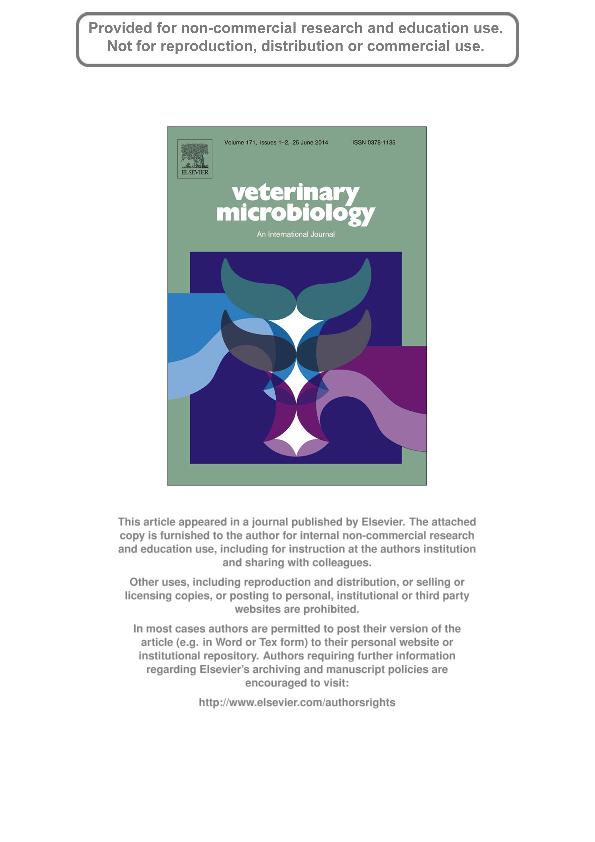Artículo
The first caprine rotavirus detected in Argentina displays genomic features resembling virus strains infecting members of the Bovidae and Camelidae
Louge Uriarte, Enrique Leopoldo ; Miño, Orlando Samuel; Badaracco, Alejandra
; Miño, Orlando Samuel; Badaracco, Alejandra ; Matthijnssens, Jelle; Zeller, Mark; Heylen, Elizabeth; Manazza, Jorge; Miño, Orlando Samuel; Van Ranst, Marc; Odeón, Anselmo Carlos; Parreño, Gladys Viviana
; Matthijnssens, Jelle; Zeller, Mark; Heylen, Elizabeth; Manazza, Jorge; Miño, Orlando Samuel; Van Ranst, Marc; Odeón, Anselmo Carlos; Parreño, Gladys Viviana
 ; Miño, Orlando Samuel; Badaracco, Alejandra
; Miño, Orlando Samuel; Badaracco, Alejandra ; Matthijnssens, Jelle; Zeller, Mark; Heylen, Elizabeth; Manazza, Jorge; Miño, Orlando Samuel; Van Ranst, Marc; Odeón, Anselmo Carlos; Parreño, Gladys Viviana
; Matthijnssens, Jelle; Zeller, Mark; Heylen, Elizabeth; Manazza, Jorge; Miño, Orlando Samuel; Van Ranst, Marc; Odeón, Anselmo Carlos; Parreño, Gladys Viviana
Fecha de publicación:
03/2014
Editorial:
Elsevier
Revista:
Veterinary Microbiology
ISSN:
0378-1135
Idioma:
Inglés
Tipo de recurso:
Artículo publicado
Clasificación temática:
Resumen
Rotavirus group A (RVA) is a major cause of diarrhea in humans and young animals including small ruminants. The purpose of this study was to identify RVA in dairy goat kids, and to characterize the complete genomic constellation and genetic relatedness with other RVA strains. Four out of twenty fecal samples from diarrheic and non-diarrheic goat kids were positive for RVA by ELISA. A representative sample was selected for further genome analyses. The RVA strain RVA/Goat-wt/ARG/0040/2011/G8P[1] displayed the following genomic constellation: G8-P[1]-I2-R5-C2-M2-A3-N2-T6-E12-H3, reminiscent to guanaco and other bovine-like RVA strains detected in Argentina. Phylogenetic analyses revealed that most of the genome segments had a rather close relatedness with RVA strains typically obtained from cattle, sheep, South American camelids and goats. Interestingly, strain 0040 possessed the R5 and E12 genotypes which have up to date only been found in different animal species from Argentina. Overall, these findings suggest that strain 0040 could represent a typical goat RVA genome constellation similar to those previously found in other animal species within the order Artiodactyla.
Palabras clave:
Rotavirus
,
Goat
,
G8p[1]
,
Argentina
Archivos asociados
Licencia
Identificadores
Colecciones
Articulos(SEDE CENTRAL)
Articulos de SEDE CENTRAL
Articulos de SEDE CENTRAL
Citación
Louge Uriarte, Enrique Leopoldo; Miño, Orlando Samuel; Van Ranst, Marc; Zeller, Mark; Odeón, Anselmo Carlos; Miño, Orlando Samuel; et al.; The first caprine rotavirus detected in Argentina displays genomic features resembling virus strains infecting members of the Bovidae and Camelidae; Elsevier; Veterinary Microbiology; 171; 1-2; 3-2014; 189-197
Compartir
Altmétricas



